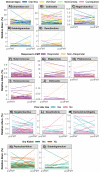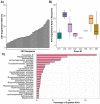Microbiome Responses to Fecal Microbiota Transplantation in Cats with Chronic Digestive Issues
- PMID: 37756083
- PMCID: PMC10537086
- DOI: 10.3390/vetsci10090561
Microbiome Responses to Fecal Microbiota Transplantation in Cats with Chronic Digestive Issues
Abstract
There is growing interest in the application of fecal microbiota transplants (FMTs) in small animal medicine, but there are few published studies that have tested their effects in the domestic cat (Felis catus). Here we use 16S rRNA gene sequencing to examine fecal microbiome changes in 46 domestic cats with chronic digestive issues that received FMTs using lyophilized stool that was delivered in oral capsules. Fecal samples were collected from FMT recipients before and two weeks after the end of the full course of 50 capsules, as well as from their stool donors (N = 10), and other healthy cats (N = 113). The fecal microbiomes of FMT recipients varied with host clinical signs and dry kibble consumption, and shifts in the relative abundances of Clostridium, Collinsella, Megamonas, Desulfovibrio and Escherichia were observed after FMT. Overall, donors shared 13% of their bacterial amplicon sequence variants (ASVs) with FMT recipients and the most commonly shared ASVs were classified as Prevotella 9, Peptoclostridium, Bacteroides, and Collinsella. Lastly, the fecal microbiomes of cats with diarrhea became more similar to the microbiomes of age-matched and diet-matched healthy cats compared to cats with constipation. Overall, our results suggest that microbiome responses to FMT may be modulated by the FMT recipient's initial presenting clinical signs, diet, and their donor's microbiome.
Keywords: FMT; antibiotics; diarrhea; domestic cats; dysbiosis; fecal microbiome; fecal transplant; gut microbiome; vomiting.
Conflict of interest statement
C.A.R., H.H.G, J.K.G., G.J., D.D.K., A.M. and Z.E. are employees of AnimalBiome, a company based in Oakland, CA and have stock options. J.A.E. is an advisor for AnimalBiome and has stock options.
Figures






Similar articles
-
Fecal Microbiota Transplantation in a Domestic Ferret Suffering from Chronic Diarrhea and Maldigestion-Fecal Microbiota and Clinical Outcome: A Case Report.Vet Med (Auckl). 2024 May 28;15:171-180. doi: 10.2147/VMRR.S449473. eCollection 2024. Vet Med (Auckl). 2024. PMID: 38828210 Free PMC article.
-
Microbiome Responses to Oral Fecal Microbiota Transplantation in a Cohort of Domestic Dogs.Vet Sci. 2024 Jan 19;11(1):42. doi: 10.3390/vetsci11010042. Vet Sci. 2024. PMID: 38275924 Free PMC article.
-
Fecal microbiota transplants modulate the gut microbiome of a two-toed sloth (Choloepus didactylus).Zoo Biol. 2023 May-Jun;42(3):453-458. doi: 10.1002/zoo.21751. Epub 2023 Jan 11. Zoo Biol. 2023. PMID: 36629092
-
The Super-Donor Phenomenon in Fecal Microbiota Transplantation.Front Cell Infect Microbiol. 2019 Jan 21;9:2. doi: 10.3389/fcimb.2019.00002. eCollection 2019. Front Cell Infect Microbiol. 2019. PMID: 30719428 Free PMC article. Review.
-
Procedures for Fecal Microbiota Transplantation in Murine Microbiome Studies.Front Cell Infect Microbiol. 2021 Sep 21;11:711055. doi: 10.3389/fcimb.2021.711055. eCollection 2021. Front Cell Infect Microbiol. 2021. PMID: 34621688 Free PMC article. Review.
Cited by
-
Fecal Microbiota Transplantation in a Domestic Ferret Suffering from Chronic Diarrhea and Maldigestion-Fecal Microbiota and Clinical Outcome: A Case Report.Vet Med (Auckl). 2024 May 28;15:171-180. doi: 10.2147/VMRR.S449473. eCollection 2024. Vet Med (Auckl). 2024. PMID: 38828210 Free PMC article.
-
Effects of black soldier fly larvae on the fecal characteristics, skin and coat health markers, immune function, and oral health measures of healthy adult cats.J Anim Sci. 2025 Jan 4;103:skaf063. doi: 10.1093/jas/skaf063. J Anim Sci. 2025. PMID: 40042979
-
Adverse events after fecal microbiota transplantation in nine cats: a case series.J Feline Med Surg. 2025 May;27(5):1098612X251337274. doi: 10.1177/1098612X251337274. Epub 2025 May 30. J Feline Med Surg. 2025. PMID: 40443229 Free PMC article.
-
Oral Fecal Microbiota Transplantation in Dogs with Tylosin-Responsive Enteropathy-A Proof-of-Concept Study.Vet Sci. 2024 Sep 18;11(9):439. doi: 10.3390/vetsci11090439. Vet Sci. 2024. PMID: 39330818 Free PMC article.
-
Case Report: Oral fecal microbiota transplantation in a Mediterranean spur-thighed tortoise (Testudo graeca) suffering from chronic gastrointestinal disease-procedure, clinical outcome and follow-up.Front Vet Sci. 2025 May 21;12:1560689. doi: 10.3389/fvets.2025.1560689. eCollection 2025. Front Vet Sci. 2025. PMID: 40470286 Free PMC article.
References
-
- Ganz H.H., Jospin G., Rojas C.A., Martin A.L., Dahlhausen K., Kingsbury D.D., Osborne C.X., Entrolezo Z., Redner S., Ramirez B., et al. The Kitty Microbiome Project: Defining the Healthy Fecal “Core Microbiome” in Pet Domestic Cats. Vet. Sci. 2022;9:635. doi: 10.3390/vetsci9110635. - DOI - PMC - PubMed
Grants and funding
LinkOut - more resources
Full Text Sources
Miscellaneous

